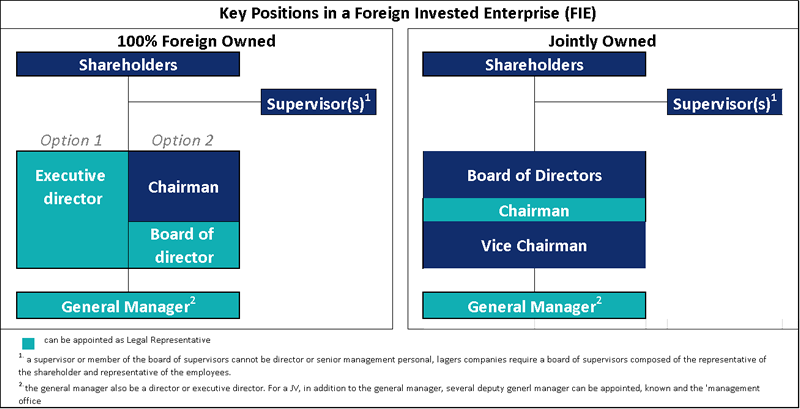The new Foreign Investment Law (FIL) entered into force in the People’s Republic of China (PRC) on 1 January 2020. It repealed the three foreign direct investment laws that previously regulated foreign invested entities (FIEs) – the Sino-Foreign Equity Joint Venture Law, the Sino-Foreign Cooperative Joint Venture Law and the Wholly Foreign-Owned Enterprise (WFOE) Law.
The establishment process for a FIE can vary, depending on the chosen structure, the entity classification and the location. The most well-known and popular classifications are Service Company, Manufacturing Company and Foreign-Invested Commercial Enterprise (FICE).
A trading company, for instance, is required to register with China Customs after obtaining a business licence, while a manufacturing company is required to complete an environmental impact evaluation report. Other options, such as the use of equipment to fulfil registered capital obligations or the use of a foreign loan to finance an operation in China will also influence the set-up process.
It is therefore always advisable to seek professional assistance when considering setting up in China. This article focuses on the set-up process for a FIE in Shanghai that is 100% owned by one or more foreign legal entities. We generally use the blanket term ‘FIE’, but in a few cases we use the terms WFOE (Wholly Foreign-Owned Enterprise) or JV (Joint Venture) in order to emphasise the type of company or the shareholder structure.
Even though the government process takes about six to eight weeks, we see set-ups in China take anywhere from three up to nine months before operations can commence. This is because the process is highly front-loaded, which means that you will need to make a number of big decisions and obtain a number of documents before you can actually start the government process.
For example, you will already need to have secured a business location. This is a key decision because it can influence what business activities your company is permitted to undertake and what incentives may be available. Selecting a location – and negotiating for the right accommodation at the right price – takes time.
The length of time may also depend on the location of the shareholders and key individuals involved in the FIE. This is because the Chinese authorities only accept ‘wet’ signatures and sending documents up and down the line can take time.
STEP 0 – HAVE A PLAN
It may sound obvious, but a comprehensive, objective business plan is an essential component for a smooth set-up. As a minimum requirement, this plan should address the following questions:
- What are the proposed activities of the business in the short and long term?
- Who will hold the key positions in the entity?
- What investments are needed make the entity operational?
- How is this investment to be financed?
- What is the cashflow plan for the next 24 months?
All this information will be needed during the set-up process and it will also help guide you to find the most suitable structure and location for your business. Of course, plans can change but having something in place to work off is always good.
STEP 1 – MAKE SOME KEY CHOICES
Your business plan will provide guidance during the government set-up process, but there will come a time when real decisions have to be made. These decisions will have to be the input into the government application and cannot (or at least not easily) be changed.
Below we discuss the points at which decisions will need to be made.
A) BUSINESS LOCATION
This is the time a business location and lease agreement needs to be confirmed. In China, you need to have a confirmed business address before your entity can officially be established.
Cheat Sheet: It is recommended that a clause be included in the contract stating that the lease can be voided if the incorporation application is rejected.
B) KEY PEOPLE IN THE FIE
This is a good time to decide on who will hold the key positions in the FIE. If the entity is to be a 100%-foreign owned (Wholly Foreign Owned Enterprise – WFOE), the following positions will need to be filled:
- Supervisor
- Executive chairman or board of directors
- General manger
- Legal Representative
The diagram below shows the options for a WFOE and a Joint venture (JV)

C) NATURE OF THE BUSINESS – THE BUSINESS SCOPE
For FIEs, the activity of the business must be declared during the licensing phase of the registration process. This is known as the ‘Business Scope’ and will determine the business categorisation of your entity in China. The following categories represent the most common classifications for FIEs operating in China today:
Service Company: A FIE providing services to either companies or consumers. In most cases, the company may not manufacture or trade goods. Examples of service activities include consulting, training, restaurants and management services.
Manufacturing Company: A FIE producing goods for sale. Manufacturing companies do not require an intermediary to sell goods locally or internationally and may import raw materials for production. The registration process, however, may be more complicated than other business categories because manufacturing plants often require additional certifications.
Foreign-Invested Commercial Enterprise (FICE): FICE provides greater flexibility in terms of business activities. These activities include retail, wholesale and franchising operations. When established, a FICE is often granted both import and export rights, although additional certifications from various bureaus will be required to commence international trade. FICEs may also buy and sell products freely in China without an intermediary. It is possible for manufacturing FIEs to apply to extend their business scope to include FICE capabilities and vice versa.
D) REGISTERED CAPITAL AND TOTAL INVESTMENT
For most companies, the amount of minimum capital will depend on the location and the nature of the business. In other words, the officials reviewing your application will determine whether the amount you intend to invest is sufficient for your business activity. Authorities in the Tier 1 Cities – Beijing, Shanghai and Guangzhou – generally regard CNY1 million (approx. USD160,000) as a baseline and work on the basis that the capital investment should be sufficient to cover two years of expenses. Ultimately the investor should invest sufficient capital to cover operating expenses until such time as it is anticipated that the FIE will be cashflow positive.
STEP 2: ONLINE APPLICATION
In Shanghai and most other well-developed cities, the company set-up process is streamlined through the online Administration for Industry & Commerce (AIC) portal. However some steps may be slightly different depending on location.
A) NAME APPROVAL
The first step in the online application is to choose a Chinese name for the entity. Many clients take a long time to choose the best name. I understand this and it is an important choice. You shouldbear in mind that the entity name can be different from the product name used in any marketing efforts. 有限公司 = ‘Youxian Gongsi’ = ‘Company limited’
Cheat Sheet: Is your brand already known in China? Have ‘netizens’ already given you a Chinese name? If so, and it is available to use, then using that name will save you time and money.
Additional guidelines restrict the content of names, forbidding the use of content that either misleads consumers or hinders fair competition, or damages or contradicts national unity, policies, social ethics, culture or religion. Special characters, such as Arabic numerals, foreign symbols or alphabets, are not permitted, and certain words such as ‘China’, ‘Chinese’, ‘National’, ‘State’ or ‘International’ can only be used under limited circumstances.
B) BUSINESS LICENCE APPLICATION
When the name has been chosen, the next step is to fill in all the details regarding the business licence. This information should include (but is not limited to):
- Registered capital, total investment and investment period
- Registered address
- FIE classification
- Business scope
- Information on the key positions
STEP 3 – HARD COPY APPLICATION
During this step, hardcopies of all the documents need to be gathered and provided to the AIC. This is the moment that the important government process starts. The following documents are needed:
- Re-signed lease agreement with company’s Chinese name
- Passports of Executive Directors / Board, Supervisor and General Manager
- Signed application documents
- Corporation documents of investors
- Commitment letter by all investors or their representatives
- Power of attorney appointing the application representatives
- Other documents, if requested
These documents must be uploaded through the online system. The commerce authorities – generally at provincial level – should verify the integrity and accuracy of the information and complete the filing within three working days.
Cheat Sheet: Use a black ink rollerball pen to sign otherwise your application will fail. A roller… what???? See link
STEP 4 – BUSINESS LICENCE
After receiving an Approval Certificate, registration and application for a business licence can be made to the local AIC within 30 days of receipt.
Cheat Sheet: Officially you now have a legal entity but it will not be very useful until it has a bank account or is registered at the local tax bureau. There are many service providers that stop here. Understand what you are paying for.
STEP 5 – CARVING CHOPS
All companies operating in China are required to have an official ‘chop’, which is round in shape and bears the official company name in Chinese. If you prefer to have a chop with the English company name, another application will need to be made. After successful registration with the AIC, a company’s seal can be obtained from the local Public Security Bureau (PSB).
Other than the official company chop, a company must also have a ‘legal representative chop’, a ‘financial chop’, a ‘fapiao chop’ and, in the case of a trading FIE, a ‘customs chop’.
STEP 6 – OPEN FOREIGN EXCHANGE AND RMB BANK ACCOUNT
An FIE in China needs to have a minimum of two banks accounts: an RMB basic account and a foreign currency capital account. An RMB basic account is essential for a FIE’s daily business operations in China. This account is the only account from which the company can withdraw RMB cash, and often acts as a designated account for making tax payments. The foreign currency capital account is necessary to receive capital injections from overseas. To open such an account, you will need approval from the State Administration of Foreign Exchange (SAFE).
Cheat Sheet: Open your capital and basic accounts with one of the Chinese banks. Trust me, it will just be easier. Do not open them with an international bank.
STEP 7 – GENERAL VAT TAXPAYER RELATED PROCEDURES
Once a business licence has been issued, the final step is to register with your local tax bureau. An FIE must register with the relevant tax bureau within 30 days. Generally, the application process takes ten working days. Companies are not required to hire an authorised agent for this process and can apply themselves. However, if the investor has used a registration service provider for the registration of the FIE, a tax application service will often be included.

Conclusion
The steps required to set up a FIE have been simplified over the years. However, components such as the amount and division of registered capital, or newly implemented regulations require in-depth knowledge. It is therefore vital to keep on top of any changes in order for the establishment process to run smoothly, particularly as a bad decision now will affect your operation in the future.
To learn more about doing business in China, setting up a FIE (WFOE), a Joint Venture or Representative office, or to understand the tax and employment system, download our free Doing Business in China guide here.
